Roman Architecture › The Barracks Emperors » Ancient origins
Articles and Definitions › Contents
- Roman Architecture › Ancient History
- The Barracks Emperors › Antique Origins
Ancient civilizations › Historical and archaeological sites
Roman Architecture › Ancient History
Definition and Origins

Roman architecture continued the legacy left by the earlier architects of the Greek world, and the Roman respect for this tradition and their particular reverence for the established architectural orders, especially the Corinthian, is evident in many of their large public buildings. However, the Romans were also great innovators and they quickly adopted new construction techniques, used new materials, and uniquely combined existing techniques with creative design to produce a whole range of new architectural structures such as the basilica, triumphal arch, monumental aqueduct, amphitheatre, granary building, and residential housing block. Many of these innovations were a response to the changing practical needs of Roman society, and these projects were all backed by a state apparatus which funded, organised, and spread them around the Roman world, guaranteeing their permanence so that many of these great edifices survive to the present day.
THE ARCHITECTURAL ORDERS
Roman architects continued to follow the guidelines established by the classical orders the Greeks had first shaped: Doric, Ionic, and Corinthian. The Corinthian was particularly favoured and many Roman buildings, even into Late Antiquity, would have a particularly Greek look to them. The Romans did, however, add their own ideas and their version of the Corinthian capital became much more decorative, as did the cornice - see, for example, the Arch of Septimius Severus in Rome (203 CE). The Romans also created the composite capital which mixed the volute of the Ionic order with the acanthus leaves of the Corinthian. The Tuscan column was another adaptation of a traditional idea which was a form of Doric column but with a smaller capital, more slender shaft without flutes, and a moulded base. The Tuscan column (as it came to be known in the Renaissance period) was especially used in domestic architecture such as peristyles and verandahs. The Romans also favoured monolithic columns rather than the Greek approach of using several drums stacked on top of each other.
ALL BUILDINGS MUST BE EXECUTED IN SUCH A WAY AS TO TAKE ACCOUNT OF DURABILITY, UTILITY & BEAUTY.
In addition, columns continued to be used even when they were no longer structurally necessary. This was to give buildings a traditional and familiar look, for example the front of the Pantheon (c. 125 CE) in Rome. Columns could be detached from the building yet remain attached to the façade at the base and entablature (free-standing columns); see, for example, Hadrian ’s Library in Athens (132 CE). Finally, columns could become a part of the wall itself (engaged columns) and function as pure decoration, for example, the upper floors of the Colosseum exterior (last quarter 1st century CE).
Greek influence is also evidenced in the fact that late Republican innovation, such as the basilica and bath buildings, usually occurred first in the south of Italy in Campania (see especially Pompeii ) which was closer to the long-established Greek colonies of Magna Graecia. It was from here that we have the oldest surviving dome building, the frigidarium (cold room) of the Stabian Baths at Pompeii (2nd century BCE). As with many other areas, the Romans took an idea and pushed it to its maximum possibility, and the huge imperial bath complexes incorporated soaring arches, arches springing directly from column capitals, and domes which spanned seemingly impossible distances.

Architectural Column Orders
The Augustan period saw a surge in building activity, innovation in design, and extravagant use of marble, symptoms of a Rome that was beginning to flex its muscles and with an increased confidence break away from the rigid tradition of earlier civilizations. This was also the time when increased imperial patronage allowed for ever bigger and more impressive building projects to be undertaken, not only in Rome itself but across the Empire, where buildings became propaganda for the might and perceived cultural superiority of the Roman world.
As the Empire expanded, ideas and even craftsmen became integrated into the Roman architectural industry, often following their familiar materials like marble to the sites of construction. The evidence of eastern influence can be seen in such features as papyrus leaves in capitals, sculptured pedestals, street colonnades, and the nymphaeum (ornamental fountain).
MATERIALS & TECHNIQUES
The first all-marble building was the Temple of Jupiter Stator in Rome (146 BCE), but it was not until the Empire that the use of marble became more widespread and the stone of choice for the most impressive state-funded building projects. The most commonly used from Italy was Carrara (Luna) marble from Tuscany (see, for example, the 30 BCE Temple of Apollo on the Palatine). Marble was also readily available from across the empire; especially esteemed were the Parian marble of Paros in the Cyclades and Pentelic from Athens. Coloured varieties were also much favoured by Roman architects, for example, yellow Numidian marble from North Africa, purple Phyrgian from central Turkey, red porphyry from Egypt, and green-veined Carystian marble from Euboea. Foreign marble was, though, mainly reserved for use in columns and, due to the costs of transportation, imperial projects.
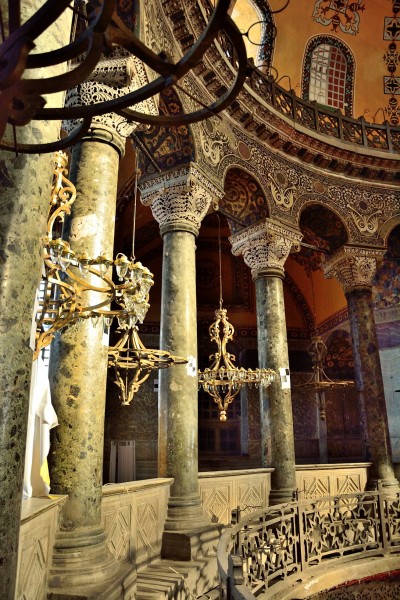
Columns of Hagia Sophia
Besides marble, travertine white limestone was also made available from quarries near Tivoli, and its favourability towards precise carving and inherent load-bearing strength made it a favourite substitute for marble amongst Roman architects from the 1st century BCE. It was especially used for paving, door and window frames, and steps.
The Romans did not invent lime mortar but they were the first to see the full possibilities of using it to produce concrete.Concrete rubble had usually been reserved for use as a filler material but Roman architects realised that the material could support great weight and could, therefore, with a little imagination, be used to help span space and create a whole new set of building opportunities. They called this material opus caementicium from the stone aggregate ( caementa ) which was mixed with the lime mortar. The material had a thick consistency when prepared and so was laid not poured like modern concrete.The first documented evidence of its use is from 3rd century BCE Cosa and its first use in Rome seems to have been a 2nd century BCE warehouse. Also in the 2nd century BCE it was discovered that by using pozzolana (concrete made using volcanic sand, pulvis puteolanus ), which had a high silica content, the concrete could set under water and was even stronger than normal concrete. By the 1st century BCE its use seems widespread in foundations, walls, and vaults. Perhaps the best example of its possibilities in construction is the Sanctuary of Fortuna Primigenia at Palestrina.
IN ADDITION TO THE STRUCTURAL POSSIBILITIES OFFERED BY CONCRETE, THE MATERIAL WAS ALSO A LOT CHEAPER THAN SOLID STONE.
In addition to the structural possibilities offered by concrete, the material was also a lot cheaper than solid stone and could be given a more presentable façade using stucco, marble veneer, or another relatively cheap material: fired brick or terracotta.Sun-dried mud bricks had been used for centuries and continued to be used for more modest projects up to the 1st century CE, but fired bricks had the advantage of durability and could be carved just like stone to resemble such standard architectural features as capitals and dentils.
Bricks were typically 59 cm square and 2.5-5 cm thick. Uncut they were used in roofing and drains, but for other uses they were usually cut into 18 triangles. There were also circular bricks, typically cut into quarters, which were used for columns.Bricks could also be used in domes such as that of the Temple of Asklepios Soter at Pergamon and even became a decorative feature themselves by using different coloured bricks (usually yellow and orange) and laid to create patterns.
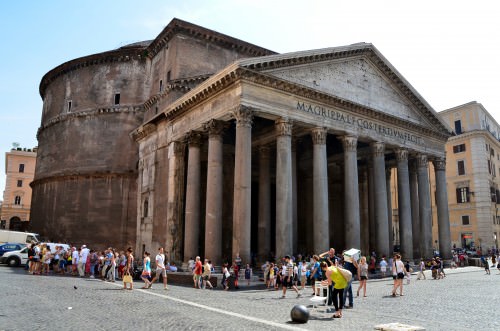
Pantheon, Rome
Stucco was used to face brick walls and could be carved, like bricks could be, to reproduce the architectural decorations previously rendered only in stone. The stucco was made from a mix of sand, gypsum, and even marble dust in the best quality material.
Volcanic tufa and pumice were used in domes because of their light weight as in, for example, the Pantheon. Basalt was often used for paving and roads, laid as polygonal blocks, and Egyptian grey and pink granite was popular for obelisks and columns.Finally, terracotta was also used for moulded ornamentation on buildings and became a common embellishment of private homes and tombs.
ROMAN ARCHITECTS
In the Roman world the credit for buildings was largely placed at the feet of the person who conceived and paid for the project rather than the architect who oversaw the realisation of it; therefore, he often remains anonymous. Those architects employed for specific projects by the emperor are better known. We know of Trajan ’s favoured architect, Apollodorus of Damascus, famed for his skills in bridge building, for example, and who was responsible for, amongst other projects, Trajan's Forum and Baths in Rome (104-9 CE). Severus and Celer were the architects responsible for the fantastic sounding revolving roof of Nero’s Golden House. In general, architects supervised whilst it was contractors ( redemptores ) who actually carried out the project based on the architect's measured drawings.
Certainly, the most famous Roman architect is Vitruvius, principally because his On Architecture, a 10-volume study of architecture, has survived intact. We do not actually know much about his own work - only a basilica he constructed in Fano and that he did work for Julius Caesar and Augustus. On Architecture covers all facets of architecture, types of building, advice for would-be architects, and much more besides. One interesting point about the work is that it reveals that the ancient architect was expected to have many skills which nowadays would be separated into different specialisations. Vitruvius also encapsulated the essential ethos of Roman architecture: 'All buildings must be executed in such a way as to take account of durability, utility and beauty.' ( On Architecture, Book I, Ch. III)

Pont del Diable Aqueduct, Tarraco
KEY ROMAN BUILDINGS
Aqueducts & Bridges - These sometimes massive structures, with single, double, or triple tiers of arches, were designed to carry fresh water to urban centres from sources sometimes many kilometres away. The earliest in Rome was the Aqua Appia (312 BCE), but the most impressive example is undoubtedly the Pont du Gard near Nimes (c. 14 CE). Roman bridges could make similar use of the arch to span rivers and ravines. Constructed with a flat wooden superstructure over stone piers or arches, examples still survive today. One of the best preserved is the granite Tagus Bridge at Alcantara (106 CE) which has arches spanning over 30 metres.
Basilicas - The basilica was adopted by the Christian church but was conceived by the Romans as a place for any large gathering, with the most common use being law courts. They were usually built along one side of the forum, the city ’s marketplace, which was enclosed on all sides by colonnades. The basilica's long hall and roof were supported by columns and piers on all sides. The columns created a central nave flanked on all sides by an aisle. A gallery ran around the first floor and later there was an apse at one or both ends. A typical example is the Severan Basilica at Lepcis Magna (216 CE).

Plan of the Baths of Diocletian
Baths - Roman baths display the typical Roman ability for creating breath-taking interior space using arches, domes, vaults, and buttresses. The largest of these often huge complexes were built symmetrically along a single axis and included pools, cold and hot rooms, fountains, libraries, under-floor heating, and sometimes inter-wall heating through terracotta piping. Their exteriors were usually plain, but within they were often sumptuous with the lavish use of columns, marble, statues and mosaics. One of the finest and certainly best surviving examples is the Baths of Caracalla in Rome (completed 216 CE).
Private Homes - Perhaps more famous for their richly decorated interior walls using fresco and stucco, Roman private residences could also enchant with atrium, peristyles, gardens and fountains, all ordered in harmonious symmetry. For a typical example, see the House of the Vettii at Pompeii (1st century BCE - 79 CE).
Even more innovative, though, were the large apartment blocks ( insula ) for the less well-off city-dwellers. These were constructed using brick, concrete, and wood, sometimes had balconies, and there were often shops on the ground floor street front. Appearing as early as the 3rd century BCE, by the 1st century BCE examples could have 12 stories, but state-imposed height restrictions resulted in buildings averaging four to five stories (at least at the front side as there were no such restrictions for the rear of the building). Some of the very few surviving examples may be seen at Ostia.

Temple of Baachus, Baalbek
Temples - The Roman temple was a combination of the Etruscan and Greek models with an inner cella at the rear of the building surrounded by columns and placed on a raised platform (up to 3.5 metres high) with a stepped entrance and columned porch, the focal point of the building (in contrast to Greek temples where all four sides could be equally important in the urban landscape). Surviving practically complete and a typical example is the Maison Carrée at Nimes (16 BCE). Temples were usually rectangular but could take other forms such as circular or polygonal, for example, the temple of Venus at Baalbeck (2nd-3rd century CE).
THE FULLY ENCLOSED AMPHITHEATRE WAS A PARTICULAR FAVOURITE OF THE ROMANS.
Theatres & Amphitheatres - The Roman theatre was of course inspired by the Greek version, but the orchestra was made semicircular and the whole made using stone. The Romans also added a highly decorative stage building ( scaenae frons ) which incorporated different levels of columns, projections, pediments, and statues such as is found in the theatre at Orange (27 BCE - 14 CE). A similar approach was taken with façades of libraries - see, for example, the Celsus Library in Ephesus(2nd century CE). Theatres also display the Roman passion for enclosing spaces, especially as they were often (partially or completely) roofed in wood or employed canvas awnings.
The fully enclosed amphitheatre was a particular favourite of the Romans. The Colosseum is the largest and most famous, and it is a typical example copied throughout the empire: a highly decorative exterior, seats set over a network of barrel vaults, and underground rooms below the arena floor to hide people, animals and props until they were needed in the spectacles.
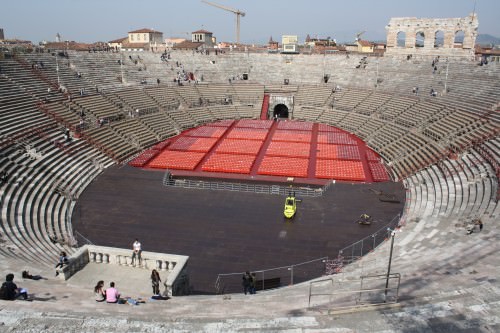
Amphitheatre of Verona
Triumphal Arches - The triumphal arch, with a single, double, or triple entrance, had no practical function other than to commemorate in sculpture and inscription significant events such as military victories. Early examples stood over thoroughfares - the earliest being the two arches set up by L.Stertinius in Rome (196 BCE) - but later examples were often protected by steps. Topped by a bronze four-horse chariot, they became imposing stone monuments to Roman vanity. The Arch of Constantine (c. 315 CE) in Rome is the largest surviving example and is perhaps the last great monument of Imperial Rome.
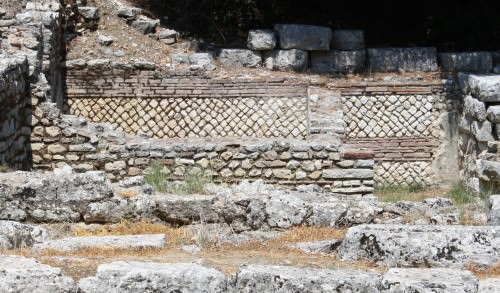
Roman Opus Mixtum Wall
- opus incertum - first appeared in the 3rd century BCE and used small irregular chunks of stone smoothed on one side.
- opus reticulatum - from the 2nd century BCE and used pyramid -shaped chunks with 6-12 cm square base and height of 8-14 cm. The stone was set with the base facing outwards and laid in diagonal arrangements.
- opus mixtum - common from the 1st century CE, this was a combination of opus reticulatum with a layer (course) of horizontal brick every fourth course and at the edges of the wall.
- opus testaceum - common from the 1st century CE and used courses of brick only.
- opus vittatum - used an alternative course of brick with two courses of tufa blocks with a rectangular side facing outwards and diminishing in size towards the inner surface. It was especially popular from the 4th century CE across the Empire.
Despite the decorative effect of these various arrangements of stone and brick, most walls were actually covered both inside and out with white plaster stucco for protection against heat and rain for the outside and to provide a smooth surface for fine decorative wall painting on the inside.
CONCLUSION
Roman architecture, then, has provided us with magnificent structures that have, quite literally, stood the test of time. By combining a wide range of materials with daring designs, the Romans were able to push the boundaries of physics and turn architecture into an art form. The result was that architecture became an imperial tool to demonstrate to the world that Rome was culturally superior because only she had the wealth, skills, and audacity to produce such edifices. Even more significantly, the Roman use of concrete, brick, and arches twinned with building designs like the amphitheatre and basilica would immeasurably influence all following western architecture right up to the present day.
The Barracks Emperors › Antique Origins
Definition and Origins

The “ Barracks Emperors ” is a term coined by later historians referring to the Roman emperors who were chosen and supported by the army during the period known as the Crisis of the Third Century (also known as the Imperial Crisis, 235-284 CE). In 235 CE Emperor Alexander Severus (222-235 CE) was assassinated by his troops who then chose their commander Maximinus Thrax (235-238 CE) as ruler. Maximinus became the first of these so-called “barracks emperors” who would continue to rule Rome right through the reign of Carinus (283-285 CE) and who characterize the period of instability in Rome during this period. The Crisis of the Third Century was resolved by Emperor Diocletian (284-305 CE) who addressed the causes of the crisis and secured the future of Rome.
The barracks emperors rose in response to a series of threats to the stability of the state, both internal and external. The Severan Dynasty, of which Alexander was the last, had begun a practice of enlarging the army while also increasing a soldier's pay. In order to afford this large military, Septimus Severus (193-211 CE) debased the currency by adding less precious metal to coins in order to produce more of them. This policy would be adhered to by later emperors and resulted in widespread inflation and a lack of confidence in purchasing power on the part of the citizens.
BARRACKS EMPERORS WERE CHOSEN BY THE MILITARY BASED ON POPULARITY WITH THE TROOPS, GENEROSITY TOWARD THE MILITARY, & ABILITY TO ATTAIN IMMEDIATE & DISCERNIBLE RESULTS.
In addition to the currency problems, a plague swept the land, depopulating and destabilizing communities, the labor force.Further, incursions by barbarian tribes across Roman borders were also upsetting the social and economic balance of the state. At the same time, the Severan Dynasty's elevation of the military (more necessary than ever to combat invasions and other external threats) placed the emperor in an almost subordinate position to his army's commanders. Emperors now felt they had to placate and court the favor of the soldiers rather than objectively govern for the good of all the citizens of Rome.
The emperor had always relied on the support of the military to some degree but now such support became more imperative.Whereas in the past an emperor came to power through a system of succession – either as the son or adopted heir of the sitting emperor – he was now chosen by the military based on his popularity with the troops, generosity toward the military, and his ability to attain immediate and discernible results. When any of these criteria were disappointed – especially the last – he was assassinated and replaced by another. This paradigm characterized all of the barracks emperors and is the major difference between them and those who ruled before and after the Crisis of the Third Century.
THE EMPERORS & THEIR REIGNS
The barracks emperors were all unique individuals with their own strengths and weaknesses, triumphs and failures but, generally speaking, were defined by a desire for the personal benefits of power without possessing the character to wield that power effectively. Because of the uncertainty of the times and the real or perceived threat of imminent invasion on the part of the populace, the Senate, and the military, a man who showed himself a strong, courageous, and – most importantly – effective military leader would be chosen as emperor by his troops. This decision was then either supported by the Roman Senate based on the person's reputation or forced on the Senate and the people by the military.
Throughout the Crisis of the Third Century, there were over 20 emperors who rose quickly to power and, in many cases, were dispatched just as fast. Even a man who would have been an able and acceptable emperor in another time might be found wanting in this period, and there was no margin for error in how an emperor comported himself or led military campaigns. Any sign of weakness or ineffectuality could be considered just cause to remove an emperor and replace him with a better.
The barracks emperors and their respective achievements, as well as their timely or untimely ends, were:
Maximinus Thrax (235-238 CE), a Thracian commander who, owing to his nationality, feared he would not be respected by the Senate or citizenry and so chose to carve out his own fame through campaigns in Germany. Although successful, these campaigns were so costly that they drained the treasury. Maximinus operated on his own whims, disregarding the pressure put on his troops or the general good of the empire. His reign resulted in civil war, as the Senate elevated others who were sent to remove him. He was killed by his own commanders in an effort to end the hostilities.
Gordian I and Gordian II (238 CE, March-April) were father and son who took part in the attempt to overthrow Maximinus.Gordian II was killed in battle fighting pro-Maximinus forces and Gordian I committed suicide upon hearing of his son's death.
Balbinus and Pupienus (238 CE, April-July) were two emperors the Senate raised to oppose Maximinus. They were unpopular with the people, who actually pelted them with stones as they walked in the street, and were eventually assassinated by the Praetorian Guard.
Gordian III (238-244 CE) co-ruled with Balbinus and Pupienus until they were assassinated and was then proclaimed emperor by the military supporters of Gordian I and Gordian II. He was only 13 years old when he came to power and was controlled by his mother and later by his father-in-law. His reign was considered ineffective, and he was assassinated, probably by his successor Philip the Arab.

Gordian III
Philip the Arab (244-249 CE) also known as Julius Philippus was the Praetorian Prefect under Gordian III and took power after assassinating him. To assure a smooth succession, he made his son, Philip II, his co-emperor and embarked on a number of successful campaigns. He concluded a peace with Persia and won a number of victories over the Goths after which he celebrated Rome's 1000th anniversary as a city. The provincial army commanders disliked him, however, and he was killed in battle by one of them: his successor Decius. Phillip II was assassinated soon after his father's death.
Decius (249-251 CE) was a senator and consul before being appointed to a command in the Danube region where he rose to power with the support of his troops. He inaugurated the systematic persecution of the Christian sect by requiring citizens to make sacrifices to the state gods in the presence of officials. This policy and the resultant martyrdom of many Christians did nothing but popularize the new faith. He followed Philip's policy and made his son his co-emperor, but both were killed in battle fighting the Goths under King Cniva at the Battle of Abritus in 251 CE.
Hostilian (251 CE, June-November), the younger son of Decius, was made co-emperor by Gallus when Decius was killed in battle. He died soon after from the plague.
Gallus (251-253 CE) was a commander under Decius who became emperor upon his death. He also made his son, Volusianus, co-emperor; both were assassinated by their own troops who elevated Aemilianus.
Aemilianus (253 CE, August-October), was a regional governor chosen by the troops who proved disappointing and so was quickly assassinated in favor of Valerian.
Valerian (253-260 CE) made his son Gallienus co-emperor as he realized the empire was too large for one man to govern.Gallienus was responsible for the western part and Valerian for the eastern section of the realm. On campaign in the east, he was captured by the Sassanid Persians and died as their prisoner. He was the first Roman emperor ever to be captured by the enemy and, as he followed Decius' policy of severely persecuting Christians, this was seized upon by the Christian sect as an act of their god and vindication of their sect.
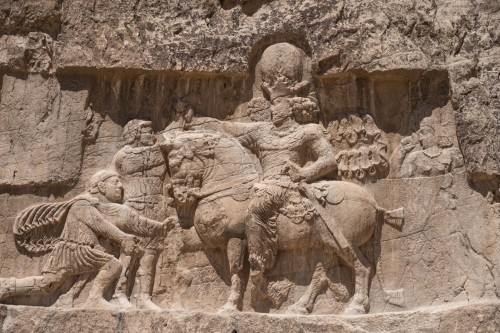
Valerian Defeated by Shapur I
Gallienus (253-268 CE) was an effective ruler and military leader who managed to control the chaos of the Roman Empire to the extent that cultural, literary, and philosophical advances developed under his reign. He also initiated a number of important changes in the military, most notably expanding the role of the cavalry. Even so, he could not escape the climate of the times and was assassinated by his own troops on campaign in a conspiracy involving the future emperor Aurelian.
Claudius Gothicus (268-270 CE) was an officer of the cavalry under Gallienus who proved himself an able leader and administrator. He defeated the Alamanni, put down a rebellion by the would-be usurper Aureolus, and received his honorary epithet “Gothicus” following his victories over the Goths. Claudius might have gone on to greater accomplishments but was stricken by the plague and died.
Quintillus (270 CE), the brother of Claudius Gothicus, came to power briefly following the latter's death but died soon after, probably assassinated by Aurelian.
Aurelian (270-275 CE) was a co-commander of Gallienus' cavalry with Claudius and, when Claudius came to power, served under him. Aurelian, like Gallienus and Claudius, is one of the few Barracks Emperors who placed the good of Rome above his own personal ambition. He restored the empire by securing its borders and bringing the breakaway territories of the Gallic and Palmyrene empires back under Roman control. Still, none of these accomplishments was enough to protect him, and he was assassinated by his commanders who feared he planned to have them executed.
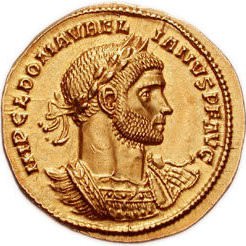
Coin Depicting Roman Emperor Aurelian
Tacitus (275-276 CE) was an elderly senator selected by the Senate as emperor following Aurelian's assassination. He ruled for only nine months, during which he was engaged in constant warfare before he died either of natural causes or – more likely – was assassinated.
Florianus (276) was the brother of Tacitus and reigned for only three months before he was assassinated by his own troops in favor of Probus.
Probus (276-282 CE) was enthusiastically supported by his troops in the Balkan region and became emperor on the death of Florianus. His reign was marked by almost continual military campaigns but, as he had a background in farming, he emphasized the importance of agriculture between engagements. This interest, according to one report, may have led to his downfall. One of his officers, Carus, became increasingly popular with the men who made him emperor while Probus was assassinated by troops who had grown tired of forced agricultural labor.
Carus (282-283 CE) was the prefect of the Praetorian Guard under Probus and avenged his former emperor's murder after he came to power. He made his sons Numerian and Carinus co-emperors and placed them in control of the west while he campaigned toward the east against the Sassanid Persians. He was reportedly killed on campaign when struck by lightning.
Numerian and Carinus (283-285 CE), Carus' sons, were co-emperors after their father's death. They both led military campaigns in attempts to secure the borders, and Carinus also successfully put down a revolt from within the empire.Numerian developed an eye disease, and either died of natural causes or was assassinated, while Carinus was killed by his own troops in battle with his successor Diocletian.
Along with these barracks emperors, there were two other rulers whose actions would have a significant impact on Rome's course during the crisis: Postumus (260-269 CE) in the west, who founded the Gallic Empire, and Zenobia (267-272 CE) in the east, queen of the Palmyrene Empire.
BREAKAWAY EMPIRES
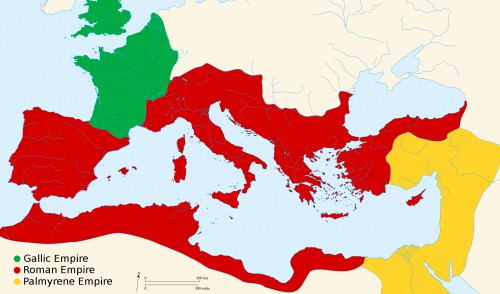
Roman Empire 271 CE
In 260 CE, Postumus marched on Cologne, took the city, and executed Saloninus and Silvanus; he then proclaimed himself emperor of the region. He sent messages to Gallienus explaining why he had acted as he did, professing his loyalty to Rome, and promising that he would not raise arms against the empire or encroach on any Roman territories. In spite of this, Gallienus could not afford to allow such a large segment of his empire – Gaul, Germania, Hispania, and Britannia – to simply leave. In 263 CE Gallienus drove his troops into Gaul in an attempt to dislodge Postumus but was wounded by an arrow in battle and withdrew.
Postumus continued his reign, and kept his promise to protect and defend Rome, until he was killed by his own troops in 269 CE when he refused to allow them to sack one of his own cities (modern-day Mainz) which had rebelled. A blacksmith (and possibly foot-solider in the army) named Marius (269 CE) was then proclaimed emperor by the troops but was assassinated shortly afterwards, and the Praetorian tribune Victorinus (269-271 CE) became emperor. Although Victorinus was an able military commander, his inability to keep his hands off other men's wives led to his murder by one of his commanders, and the usurper Domitianus (271 CE) took control. He was defeated in battle by Tetricus I (271-274 CE), an able administrator and military leader and considered the only true successor to Postumus.
Tetricus I made his son (also named Tetricus) co-emperor to share the responsibilities of government and run the empire more efficiently. He stabilized the region, putting down rebellions by the German tribes, but his reign was interrupted – and then ended – by Aurelian in 274 CE at the Battle of Chalons. Aurelian marched on the Gallic Empire after defeating and reabsorbing the Palmyrene Empire which had formed under the queen Zenobia, wife of the late Roman governor of the region, Odaenthus.

Coin Depicting Roman Emperor Tetricus
When Valerian was captured in 260 CE, and Gallienus could do nothing about it, the Roman governor of Syria, Odaenthus, raised an army and attacked the Persians. Although he failed to free Valerian, he did push the Persian forces back from the borders of the eastern side of the Roman empire. He further served Gallienus by helping put down a rebellion inside the empire by a would-be usurper, and for these efforts, Gallienus made him governor of the entire eastern part of the empire which ran from Syria down through the Levant.
Odaenthus was killed on a hunting trip in 266/267 CE, and his wife Zenobia became regent for their young son Vaballathus.Zenobia, like Postumus, was careful not to alienate her realm from Rome or antagonize the emperor but entered into negotiations with neighboring states, annexed Egypt, issued her own currency, and had herself and her son addressed by titles reserved only for the ruling family of Rome.
She had her own court, her own seal, her own commander-in-chief, and her own army, and was empress of her own empire in everything but official title. She seems to have hoped, like Postumus, that by remaining on good terms with Rome and performing military services which only benefited the empire, that she would be left alone to rule her region and her son might one day be chosen emperor.
Zenobia was, in fact, left alone while the emperors of Rome were engaged in their perpetual warfare with outside threats and each other, but when Aurelian came to power, he turned his attention east as quickly as possible. At the Battle of Immae in 272 CE, he defeated Zenobia's forces and drove her back to Emessa where, in a second engagement, he was again victorious. With Zenobia defeated and her Palmyrene Empire again joined to Rome, Aurelian marched west and defeated Tetricus I in 274 CE, ending the Gallic Empire.
Aurelian showed mercy to both Zenobia and Tetricus I, as well as most of the cities and towns he marched on, and after restoring the empire set himself to the task of remedying the underlying causes of the Crisis of the Third Century. It is likely that he thought his show of mercy to his enemies would dissuade future rebellions but never found out as he was assassinated in 275 CE by his commanders.
DIOCLETIAN'S REFORMS
The Crisis of the Third Century and the reign of barracks emperors would continue after Aurelian until Diocletian came to power in 284 CE. Diocletian developed the policies of the best of the barracks emperors, Gallienus and Aurelian, in reforming the military, tightening the borders of the empire, and also introducing reforms in currency and the government. His tetrarchy (rule of four) divided the operation of the government between two men who had successors already in place when they took their positions; this ensured ease of succession and prevented the rise of would-be usurpers.
The time of the crisis and the barracks emperors passed into history as Diocletian went further in dividing the empire in two – the Eastern Roman Empire and the Western Roman Empire – as he realized the realm had grown too vast to be governed by one man or even by four. The mistake made by most of the barracks emperors was the belief that one could wield political power primarily for one's individual benefit rather than the good of one's state and fellow citizens. Consequently, they could easily be replaced when their methods or personal choices no longer suited the military or citizens. Neither of these groups had anything to lose in replacing one selfish ruler with another more to their liking. This model became so accepted that not even the best of the emperors could feel secure in their positions. Only after Diocletian's reforms would the model change and ensure the future of Rome for the next generations.
LICENSE:
Article based on information obtained from these sources:with permission from the Website Ancient History Encyclopedia
Content is available under License Creative Commons: Attribution-NonCommercial-ShareAlike 3.0 Unported. CC-BY-NC-SA License